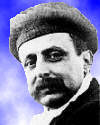 | TODAY IN SCIENCE HISTORY NEWSLETTER - 25 JULY |
| Feature for Today |
 On 25 July 1843, a Scottish chemist and inventor died. He created a waterproof cloth (1823), by pressing together two rubberized layers of cloth, and his name remains associated with a particular item of waterproof clothing made from it. His name is a part of the quiz below. You probably know it, or at least his last name. On 25 July 1843, a Scottish chemist and inventor died. He created a waterproof cloth (1823), by pressing together two rubberized layers of cloth, and his name remains associated with a particular item of waterproof clothing made from it. His name is a part of the quiz below. You probably know it, or at least his last name.As with many inventors, this one product may be all you know of his work. Yet, as a trained chemist, he pursued various ideas in his lifetime. If you would like to extend your knowledge, you can find out more about this man in this Biography. |
| Book of the Day | |
| |
| Quotations for Today | |
 | "You look at science (or at least talk of it) as some sort of demoralising invention of man, something apart from real life, and which must be cautiously guarded and kept separate from everyday existence. But science and everyday life cannot and should not be separated. Science, for me, gives a partial explanation for life. In so far as it goes, it is based on fact, experience and experiment." |
| | "It is interesting to note how many fundamental terms which the social sciences are trying to adopt from physics have as a matter of historical fact originated in the social field. Take, for instance, the notion of cause. The Greek aitia or the Latin causa was originally a purely legal term. It was taken over into physics, developed there, and in the 18th century brought back as a foreign-born kind for the adoration of the social sciences. The same is true of the concept of law of nature. Originally a strict anthropomorphic conception, it was gradually depersonalized or dehumanized in the natural sciences and then taken over by the social sciences in an effort to eliminate final causes or purposes from the study of human affairs. It is therefore not anomalous to find similar transformations in the history of such fundamental concepts of statistics as average and probability. The concept of average was developed in the Rhodian laws as to the distribution of losses in maritime risks. After astronomers began to use it in correcting their observations, it spread to other physical sciences; and the prestige which it thus acquired has given it vogue in the social field. The term probability, as its etymology indicates, originates in practical and legal considerations of probing and proving." |
 | "The number of travellers by gigs, the outside of coaches, and on horseback, have, since the introduction of railways, been prodigiously diminished; and as, in addition, the members of the medical faculty having lent their aid to run down the use of water-proof (apparently having found it decided enemy against their best friends colds and catarrhs), the use of the article in the form of cloaks, etc., has of late become comparatively extinct." (Referring to the disappearing use of his invention of a waterproof cloth.) |
| QUIZ | |
| Before you look at today's web page, see if you can answer some of these questions about the events that happened on this day. Some of the names are very familiar. Others will likely stump you. Tickle your curiosity with these questions, then check your answers on today's web page. | |
| Births | |
 |  An English scientist, born 25 Jul 1920, contributed to the discovery of the molecular structure of deoxyribonucleic acid (DNA), a constituent of chromosomes that serves to encode genetic information. Beginning in 1951, she made careful X-ray diffraction photographs of DNA, leading her to suspect the helical form of the molecule, at least under the conditions she had used. When Watson saw her photographs, he had confirmation of the double-helix form that he and Crick then published. She never received the recognition she deserved for her independent work, but had died of cancer four years before the Nobel Prize was awarded to Crick and Watson. An English scientist, born 25 Jul 1920, contributed to the discovery of the molecular structure of deoxyribonucleic acid (DNA), a constituent of chromosomes that serves to encode genetic information. Beginning in 1951, she made careful X-ray diffraction photographs of DNA, leading her to suspect the helical form of the molecule, at least under the conditions she had used. When Watson saw her photographs, he had confirmation of the double-helix form that he and Crick then published. She never received the recognition she deserved for her independent work, but had died of cancer four years before the Nobel Prize was awarded to Crick and Watson. Can you name this woman? Can you name this woman? |
 |  On 25 Jul 1874, Sergey Vasilyevich Lebedev was born, a Russian chemist who developed a method for industrial production of synthetic elastic rubber. He polymerized a four-carbon molecule which he derived from ethyl alcohol. Production applying his process began in the Soviet Union in 1932-33, using potatoes and limestone as raw materials. By 1940, the Soviet Union had the world's largest synthetic rubber industry, producing over 50,000 tons per year. On 25 Jul 1874, Sergey Vasilyevich Lebedev was born, a Russian chemist who developed a method for industrial production of synthetic elastic rubber. He polymerized a four-carbon molecule which he derived from ethyl alcohol. Production applying his process began in the Soviet Union in 1932-33, using potatoes and limestone as raw materials. By 1940, the Soviet Union had the world's largest synthetic rubber industry, producing over 50,000 tons per year. Which synthetic rubber polymer did Lebedev produce? Which synthetic rubber polymer did Lebedev produce? |
| Deaths | |
 |  A Scottish chemist and manufacturer (1766-1843) began a career in the textile industry in a cloth bleaching business. Meanwhile, trying to find uses for the waste products from gasworks, he developed a method of waterproofing cloth (1823), by pressing together two rubberized layers of cloth. His name remains associated with the raincoat made from such cloth. A Scottish chemist and manufacturer (1766-1843) began a career in the textile industry in a cloth bleaching business. Meanwhile, trying to find uses for the waste products from gasworks, he developed a method of waterproofing cloth (1823), by pressing together two rubberized layers of cloth. His name remains associated with the raincoat made from such cloth. Can you name this man? Can you name this man? |
 |  Charles Stark Draper, an American aeronautical engineer (1901-1987) became known as the “father of inertial navigation.” Chances are, you've played with a toy version of the device he incorporated into systems that stablilized and balance gunsights and bombsights, and which were later expanded to an inertial guidance system for launching long-range missiles at supersonic jet targets. Charles Stark Draper, an American aeronautical engineer (1901-1987) became known as the “father of inertial navigation.” Chances are, you've played with a toy version of the device he incorporated into systems that stablilized and balance gunsights and bombsights, and which were later expanded to an inertial guidance system for launching long-range missiles at supersonic jet targets. What was the basic device he incorporated into bombsights and his inertial guidance system? What was the basic device he incorporated into bombsights and his inertial guidance system? |
| Events | |
 |  On 25 Jul of a certain year, a hovercraft crossed the English Channel for the first time. Having been shipped to France by tender, the world's first all metal hovercraft, SR.N1, crossed the Channel between Calais and Dover in 2 hours 3 minutes. On 25 Jul of a certain year, a hovercraft crossed the English Channel for the first time. Having been shipped to France by tender, the world's first all metal hovercraft, SR.N1, crossed the Channel between Calais and Dover in 2 hours 3 minutes. In what decade did this first hovercraft crossing of the English Channel take place? In what decade did this first hovercraft crossing of the English Channel take place? |
 |  On 25 Jul 1925, the jury in the “Scopes Monkey Trial” took just nine minutes to decide that John Scopes was guilty under the Tennessee statue fobidding the teaching of evolution. The judge determined that Scopes should be fined $100. About 18 months later, on the verdict was overturned on a technicality, by the Tennessee Supreme Court, which still found law was constitutional. On 25 Jul 1925, the jury in the “Scopes Monkey Trial” took just nine minutes to decide that John Scopes was guilty under the Tennessee statue fobidding the teaching of evolution. The judge determined that Scopes should be fined $100. About 18 months later, on the verdict was overturned on a technicality, by the Tennessee Supreme Court, which still found law was constitutional.  What technicality overturned the verdict? In what decade was the state law repealed? What technicality overturned the verdict? In what decade was the state law repealed? |
 |  On 25 Jul 1909, French aviator Louis Blériot flew in a monoplane on the world's first international overseas airplane flight. On 25 Jul 1909, French aviator Louis Blériot flew in a monoplane on the world's first international overseas airplane flight.  Between which two countries did he fly? Between which two countries did he fly? |
| Answers |
When you have your answers ready to all the questions above, you'll find all the information to check them, and more, on the July 25 web page of Today in Science History. Or, try this link first for just the brief answers. Fast answers for the previous newsletter for July 24: Amelia Earhart; the link between lung cancer and cigarette smoking; James Chadwick; the decade including the year 1950; rotary-type printing press. |
| Feedback |
 If you enjoy this newsletter, the website, or wish to offer encouragement or ideas, please send feedback by using your mail reader Reply button. If you enjoy this newsletter, the website, or wish to offer encouragement or ideas, please send feedback by using your mail reader Reply button. |
--
If you do not want to receive any more newsletters, this link
To update your preferences and to unsubscribe visit this link
If you do not want to receive any more newsletters, this link
To update your preferences and to unsubscribe visit this link
! !



Δεν υπάρχουν σχόλια:
Δημοσίευση σχολίου